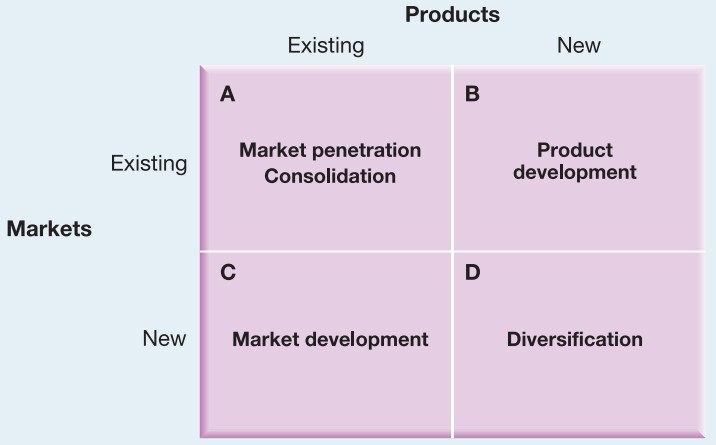What is the Ansoff Matrix?
To make sure their company grows and develops in a long-term perspective, business owners, leaders, and managers must find new ways to generate profits and expand their customer base. This idea is at the health of the Ansoff Matrix, which is also known as the Product/Market Expansion Grid. Developed by Igor Ansoff, a Russian-American mathematician and business manager, the Ansoff Matrix is an essential framework for strategic planning that allows for plotting generic strategies for growing a business. The model was firstly published in the Harvard Business Review back in 1957 (Ansoff, 1957). And it still remains one of the most widely used strategic management instruments that help leaders and marketers better understand the risks of growing their company.
Using the Tool
The Ansoff Matrix, which is shown below, considers four major ways to grow a business, namely market penetration, market development, product development, and diversification.
Figure 1: The Ansoff Matrix
Source: Johnson et al. (2008, p.258)
Market Penetration
Market penetration aims at increasing a firm’s sales of existing products/services to existing customers. It is the least risky of the four options because companies that follow this strategy know their product works so you can always sell some more of it to your customers. The attractiveness of this strategy stems from the fact that you can leverage many of your firm’s existing capabilities and resources. If a market is growing, maintaining market share will inevitably lead to growth. In addition, if rivals reach their capacity limits, there might be additional business growth opportunities. Diet Coke is a good example of market penetration since it opened up a whole new market for The Coca-Cola Company (2020). However, once the market reaches saturation, the effectiveness of this growth strategy falls sharply, forcing business entities to pursue another, more risky strategy if it is to continue to grow.
Product Development
The product development strategy falls into the higher right quadrant of the Ansoff Matrix. It is riskier than market penetration since the company following this strategy has to introduce a new product or service into its existing market. It involves more significant financial resources since product development is usually associated with extensive research and development (R&D). Nonetheless, this strategy proves highly effective since you can leverage the capabilities of your business by developing a product that is related to your existing customers. This strategy can be followed if the business entity has a clear understanding of its target market and the needs and expectations of its customers. Nissan responded to the growing environmental concerns amongst its customers by introducing the Leaf model, the first electric vehicle in the world (Nissan Motors, 2020). The key disadvantage of the product development strategy is that entering untested territory is always a risk associated not only with uncertain consumer demand, but also with unfamiliar production processes.
Market Development
The market development strategy, which falls into the lower left quadrant of the Product/Market Expansion Grid, implies entering a new market with the company’s existing products and services. This growth strategy often takes the form of pursuing additional market segments or geographical areas. By adding new features to the product and finding a new use for it, the company can also develop new markets and attract new customers. Unlike product development, market development might be an attractive option if the firm’s core competencies relate more to the specific product. Footwear and sports apparel brands, such as Nike, Adidas, and Puma are all known for their market development strategies, which continue to expand across new geographical markets. You can find their branded stores in almost any country you visit. The implementation of this strategy is costly because the business entity has to build new locations and expand its marketing efforts in its attempt to increase market share.
Diversification
This is the riskiest growth strategy of the four alternatives because it involves the development of new products as well as markets, meaning the risks of these activities multiply. For this reason, diversification is often called the ‘suicide cell’ of the Product/Market Expansion Grid (Campbell et al., 2012). You can find a relatively small number of successful product diversification examples in real life, such as Elsevier’s division LexisNexis and Apple’s iPad. Yet, diversification is the most profitable growth strategy, which paradoxically helps business entities reduce their overall business portfolio risk.
How to Use the Ansoff Matrix
The Ansoff Matrix can be rightfully put on a par with other fundamental marketing and management frameworks, such as Poster’s Five Forces for its popularity with management and marketing researchers and practitioners. If you are writing a report or any other type of academic assignment that requires you to apply this instrument, here are the three basic steps you should follow to accomplish this task.
1. Analyse your growth options
The first thing you should do is to classify different approaches pertaining to each quadrant of the Ansoff Matrix. You can easily do it by referring to our description of the framework above. You might also want to use some other frameworks, such as PEST, the marketing mix, or Boston Matrix to make your classification even more detailed.
2. Assess risks
At this point, you should conduct a risk analysis to know exactly what challenges and dangers are associated with each potential growth strategy. You might want to prioritise the identified risks if there are too many of them.
3. Select your option
Having identified your options and assessed their benefits and risks, you might now have a sense of which of the four strategies fits your company.
How We Can Help
Although the Ansoff Matrix seems a relatively easy framework at glance, the analysis and selection of the most suitable growth strategy might be a complex and lengthy process. If you are looking for assistance in conducting a strategic analysis using this or any other marketing or management framework, we are here to help you. Our experienced writers will closely follow all your instructions and meet the standards of your university to make sure your report or dissertation is of the highest quality possible.
References
Ansoff, I. (1957) “Strategies for diversification”, Harvard Business Review, 35 (5), pp. 113-124.
Campbell, R., Pentz, E. and Borthwick, I. (2012) Academic and Professional Publishing, Oxford: Elsevier.
Coca-Cola Company, The (2020) “The Extraordinary Story of How Diet Coke Came to Be”, [online] Available at: https://www.coca-colacompany.com/news/the-extraordinary-story-of-how-diet-coke-came-to-be [Accessed on 15 May 2020].
Johnson, G., Scholes, K. and Whittington, R. (2008) Exploring corporate strategy, London: Pearson Education.
Nissan Motors (2020) “Nissan Leaf”, [online] Available at: https://www.nissan-global.com/EN/TECHNOLOGY/OVERVIEW/leaf.html [Accessed on 15 May 2020].


